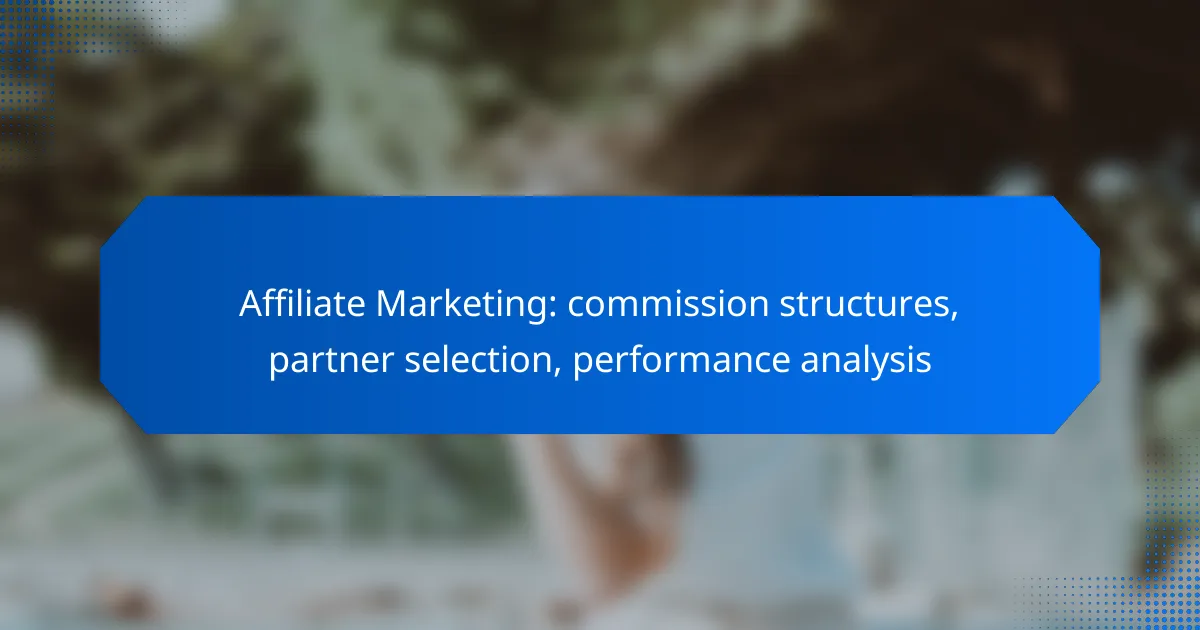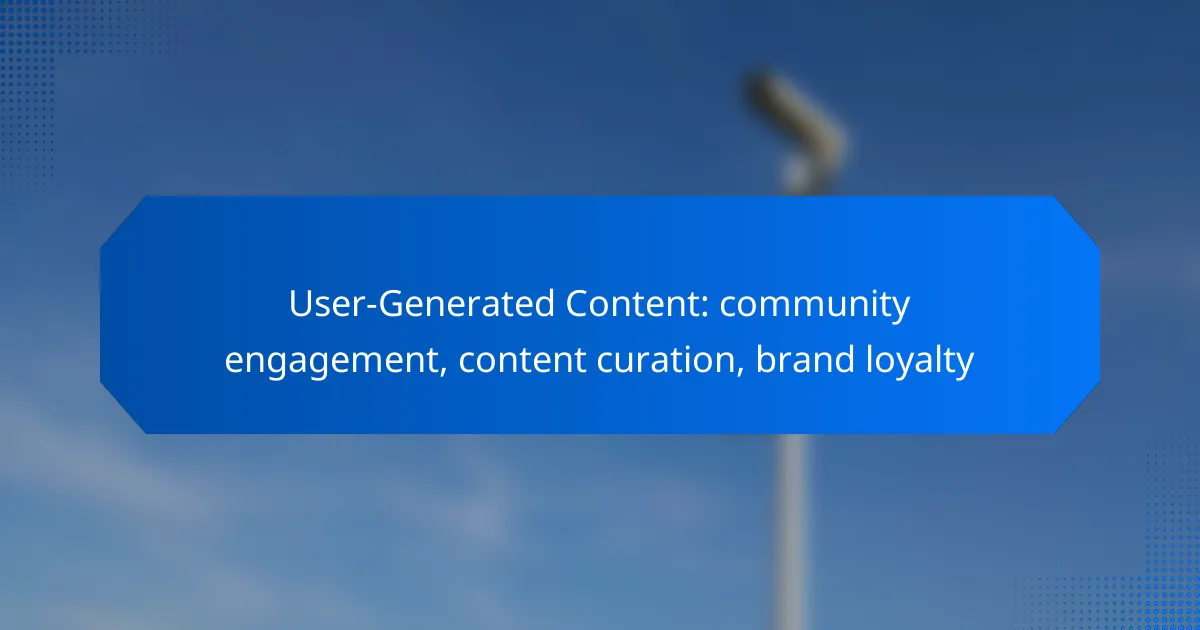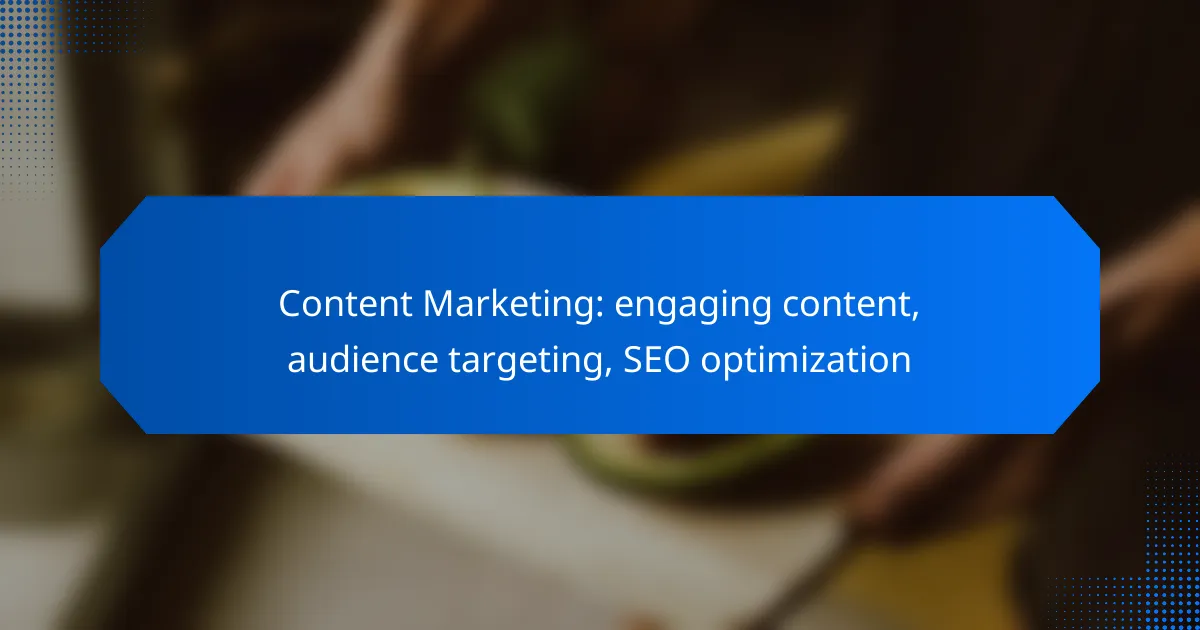
Webinar marketing is a powerful tool for connecting with your audience, and it starts with selecting relevant topics that resonate with their interests and current industry trends. Engaging your audience during the session is essential, utilizing interactive elements and diverse perspectives to create a memorable experience. Additionally, implementing effective follow-up strategies post-webinar can strengthen relationships and encourage ongoing participation.
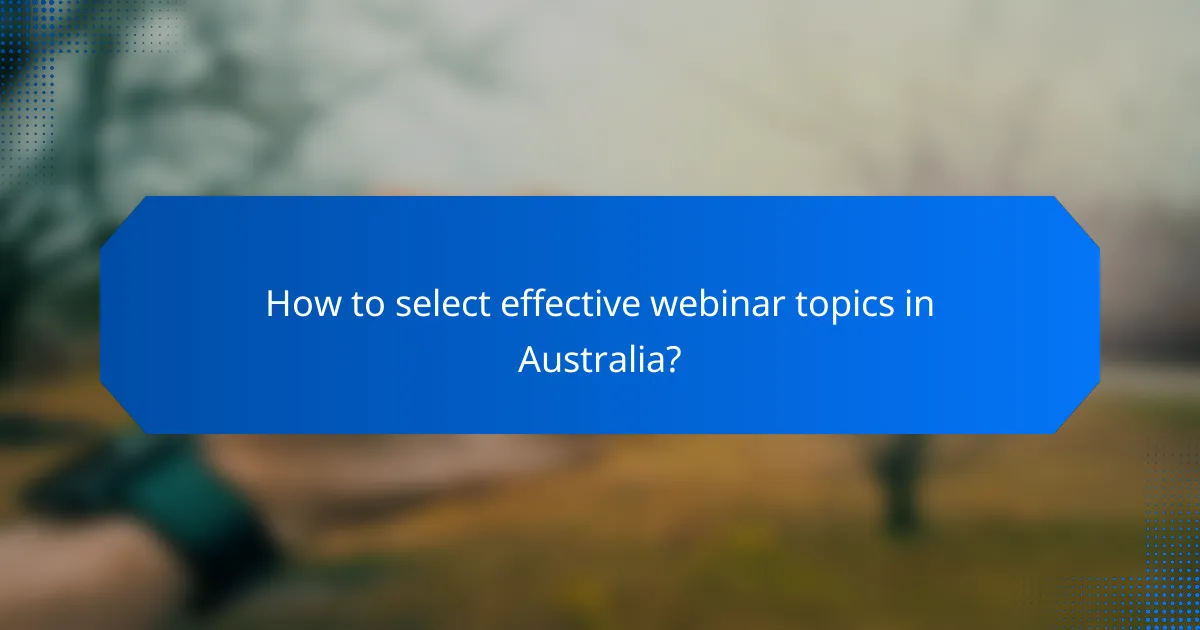
How to select effective webinar topics in Australia?
Selecting effective webinar topics in Australia involves understanding your target audience’s needs and interests while aligning with current industry trends. Consideration of these factors will help ensure your webinars attract participants and provide valuable insights.
Industry trends and audience interests
To choose relevant webinar topics, stay updated on industry trends that resonate with your audience. Research popular themes within your sector, such as emerging technologies or regulatory changes, and consider how these can be translated into engaging content.
Utilize online forums, social media, and industry publications to gauge what topics are currently capturing attention. This will help you tailor your content to meet the evolving interests of your audience.
Competitive analysis of successful webinars
Analyze successful webinars within your industry to identify effective topics and presentation styles. Look for webinars that have high attendance rates and positive feedback, noting their subject matter and format.
Consider creating a comparison table of these webinars, highlighting key aspects such as duration, speaker expertise, and participant engagement strategies. This can provide insights into what works and help you refine your own topic selection.
Utilizing audience surveys for topic selection
Conducting audience surveys is an effective way to gather direct feedback on potential webinar topics. Use simple online tools to create surveys that ask participants about their interests, challenges, and preferred formats.
Incorporate questions that allow for open-ended responses to capture nuanced insights. Analyzing survey results will enable you to prioritize topics that resonate most with your audience, ensuring higher engagement and attendance rates.
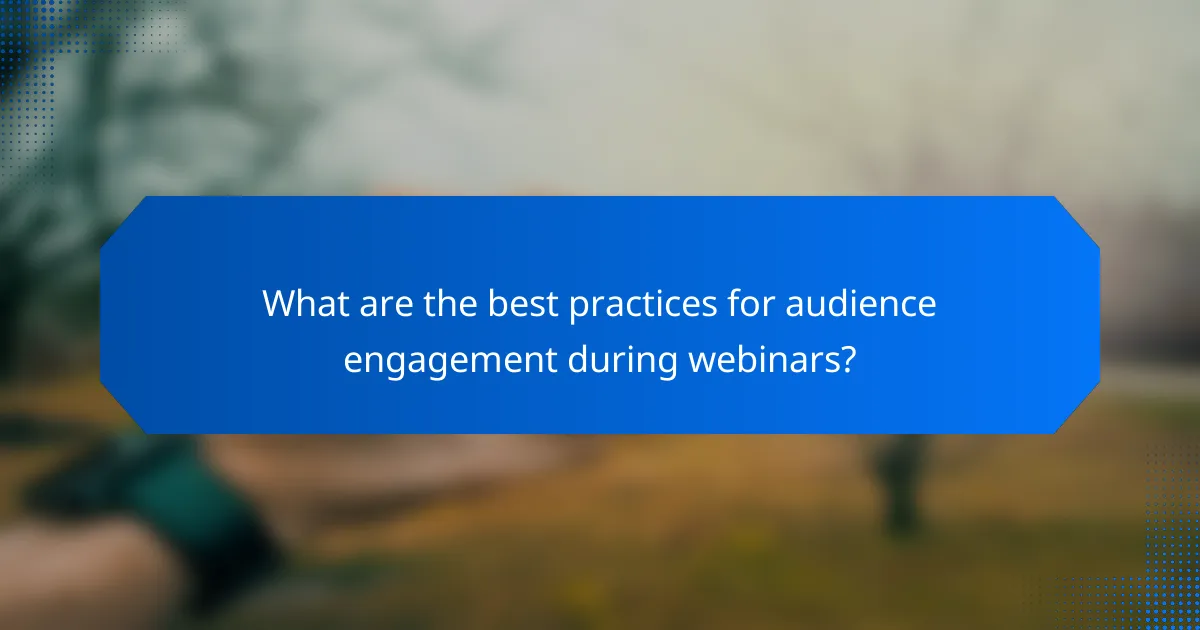
What are the best practices for audience engagement during webinars?
Effective audience engagement during webinars is crucial for maintaining interest and ensuring participant interaction. Best practices include using interactive elements, engaging visuals, and incorporating diverse perspectives to create a dynamic experience.
Interactive polls and Q&A sessions
Interactive polls and Q&A sessions are powerful tools for engaging your audience. Polls can gauge participant opinions in real-time, while Q&A sessions allow attendees to ask questions, fostering a sense of involvement. Aim to include at least one poll and a dedicated Q&A segment in every webinar.
To maximize effectiveness, keep polls short and relevant, ideally focusing on key topics discussed during the session. Encourage questions throughout the presentation, not just at the end, to maintain engagement and address concerns as they arise.
Utilizing engaging visuals and storytelling
Engaging visuals and storytelling can significantly enhance audience retention and interest. Use high-quality images, infographics, and videos to illustrate key points and break up text-heavy slides. Storytelling can help contextualize your content, making it relatable and memorable.
When crafting your narrative, aim for a clear structure: introduce the problem, present the solution, and share a relevant case study or example. This approach not only captivates but also helps the audience connect emotionally with the material.
Incorporating guest speakers for diverse perspectives
Incorporating guest speakers can enrich your webinar by providing diverse perspectives and expertise. This approach not only adds credibility but also keeps the content fresh and engaging. Consider inviting industry experts or thought leaders who can offer insights that complement your topic.
When selecting guest speakers, ensure they align with your audience’s interests and the webinar’s objectives. Prepare them with clear guidelines on their role and the topics they should cover, allowing for a seamless integration into your presentation.

How to follow up with attendees after a webinar?
Following up with attendees after a webinar is crucial for maintaining engagement and fostering relationships. Effective follow-up strategies can enhance attendee experience and encourage future participation.
Sending personalized thank-you emails
Sending personalized thank-you emails is a simple yet effective way to show appreciation to your attendees. Tailor each email by including the attendee’s name and referencing specific topics discussed during the webinar to create a more personal touch.
Consider sending these emails within 24 hours of the webinar to keep the experience fresh in their minds. A well-crafted thank-you note can significantly improve attendee satisfaction and loyalty.
Providing access to recorded sessions
Providing access to recorded sessions allows attendees to revisit the content at their convenience. This is especially valuable for those who may have missed parts of the live event or want to share the information with colleagues.
Make the recording easily accessible through a link in your follow-up email. You can also consider hosting the recording on your website or a video platform, ensuring it is available for a reasonable duration, such as a few weeks or months.
Offering additional resources and next steps
Offering additional resources and outlining next steps can enhance the value of your webinar follow-up. Include links to relevant articles, e-books, or tools that complement the webinar content, helping attendees deepen their understanding.
Clearly outline any actions you want attendees to take, such as signing up for a newsletter, joining a community, or registering for future webinars. This not only keeps them engaged but also guides them on how to apply what they learned.

What are the key metrics for measuring webinar success?
Key metrics for measuring webinar success include attendance rates, engagement levels, and post-event feedback. These metrics provide insights into how well the webinar resonated with the audience and areas for improvement.
Attendance rates and engagement levels
Attendance rates indicate the percentage of registered participants who actually joined the webinar. A typical attendance rate ranges from 30% to 50%, depending on the industry and the effectiveness of your promotional strategies.
Engagement levels can be gauged through participant interactions, such as questions asked, polls answered, and chat activity. High engagement often correlates with better retention of information and a more impactful experience for attendees.
Post-webinar feedback and surveys
Post-webinar feedback is crucial for understanding participant satisfaction and areas for improvement. Surveys should be sent shortly after the event, ideally within 24 hours, to capture fresh impressions.
Consider using a mix of quantitative and qualitative questions, such as rating the content on a scale of 1 to 5 and asking open-ended questions about what participants liked or what could be improved. This feedback can guide future webinars and enhance overall effectiveness.
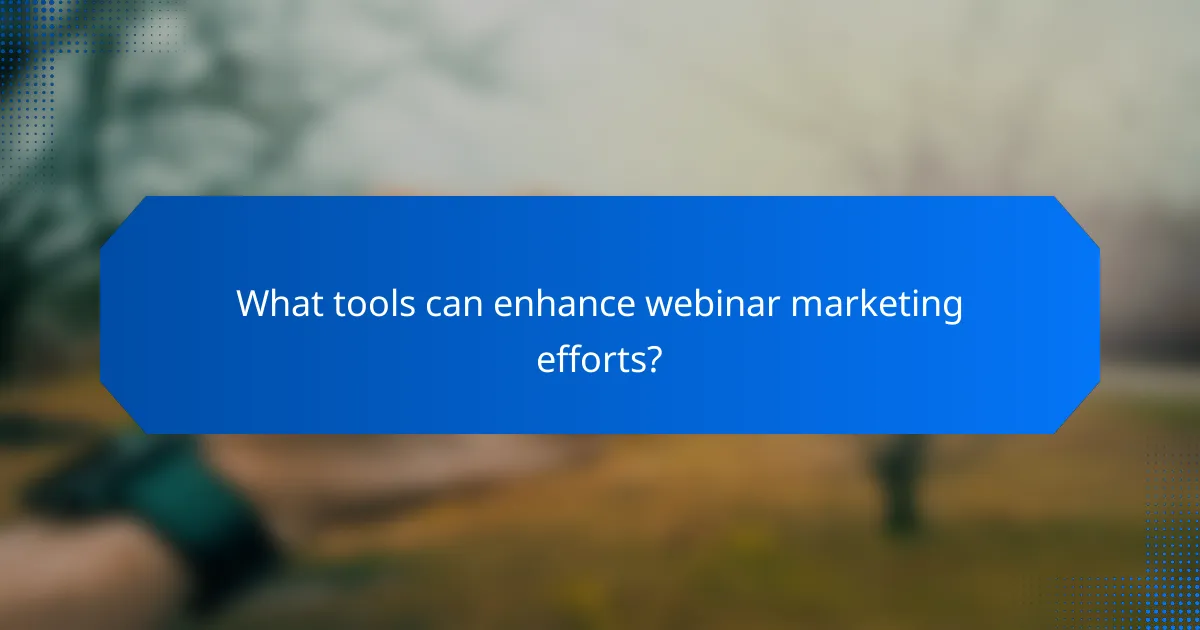
What tools can enhance webinar marketing efforts?
Several tools can significantly improve webinar marketing efforts by streamlining hosting, follow-ups, and promotional activities. Utilizing the right platforms can enhance audience engagement, ensure effective communication, and boost attendance rates.
Zoom for hosting and engagement
Zoom is a leading platform for hosting webinars, offering features that facilitate audience interaction. It allows for real-time Q&A sessions, polls, and breakout rooms, which can enhance participant engagement and create a more interactive experience.
When using Zoom, consider setting up registration to collect attendee information and sending reminders to boost attendance. The platform supports various integrations, making it easy to connect with other marketing tools for a seamless experience.
Mailchimp for email follow-ups
Mailchimp is an effective tool for managing email follow-ups after webinars. It enables you to segment your audience and tailor messages based on their engagement level, which can improve your chances of converting leads into customers.
To maximize effectiveness, create a series of follow-up emails that include thank-you notes, links to recorded sessions, and additional resources. Aim to send these emails within a few days of the webinar to keep the content fresh in attendees’ minds.
Canva for creating promotional materials
Canva is a user-friendly design tool that helps create eye-catching promotional materials for webinars. You can design social media graphics, email headers, and event flyers that align with your branding and attract more participants.
When using Canva, leverage templates to save time and ensure consistency across your materials. Focus on clear messaging and strong visuals to convey the value of your webinar, and consider using A/B testing for different designs to see which performs better in attracting attendees.

How to integrate webinars into a broader marketing strategy?
Integrating webinars into a broader marketing strategy involves aligning them with your overall business objectives and ensuring they complement other marketing efforts. This synergy enhances audience engagement, drives leads, and ultimately boosts conversions.
Aligning webinars with content marketing goals
To effectively align webinars with content marketing goals, identify key topics that resonate with your target audience and support your brand messaging. Consider using webinars to expand on popular blog posts or whitepapers, providing deeper insights and fostering engagement.
Establish clear objectives for each webinar, such as increasing brand awareness or generating leads. This helps in measuring success and refining future content strategies. For instance, if your goal is lead generation, incorporate strong calls-to-action and follow-up processes.
Utilizing social media for promotion
Social media is a powerful tool for promoting webinars, allowing you to reach a wider audience and drive registrations. Use platforms like Facebook, LinkedIn, and Twitter to share engaging content related to your webinar topic, including teaser videos and infographics.
Consider creating a dedicated event page on social media to facilitate discussions and share updates. Additionally, leverage paid advertising to target specific demographics, ensuring your promotion reaches the right audience. Regularly engage with followers to build anticipation and encourage sharing.
